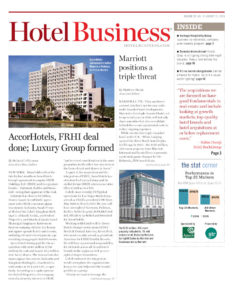NATIONAL REPORT—Today’s travelers expect quiet guestrooms. In addition to late-night corridor parties or noisy guest neighbors, one of the most common noise complaints in midscale and economy hotels comes from loud PTACs, which can disturb their sleep experience.
“One thing often overlooked is that the problem with PTAC noise is not so much the actual decibel level as much as the noise cycling on and off,” said Blair Hildahl, founding partner of Base4, a Boca Raton, FL-based hospitality design and engineering firm. “PTACs have a compressor inside that cycles on and off as the guestroom thermostat calls for cooling demand. Sometimes a sudden jolt of noise from an otherwise quiet room can be much more disruptive than a constant noise at the same decibel level.”
Guests of lower-to-midscale properties have come to expect that a PTAC in the guestroom will create some noise while operating, according to Hildahl. “Some of the newer PTAC models do a better job of reducing noise levels, but ultimately, there is still a compressor, often only a few feet from the guest bed so there is only so much you can do to mask this noise,” he said.
Controlling noise pollution in hotels, satisfying franchise-specific soundproofing requirements and limiting the sound transfer in a lodging property are critical elements to the design process.
According to Hildahl, an important factor to consider is Sound Transmission Class (STC) ratings, which measure how much a barrier would reduce sound.
“An STC is the most common measurement used for sound reduction,” Hildahl said. “It is a rating of how well a wall, floor, door or window assembly diminishes airborne sound and prevents it from passing from one side to the other.”
Higher values show that more sound is effectively isolated. “An STC rating of 25 is roughly equivalent to normal speech not being heard through the assembly, whereas an STC rating of 50 is equivalent to loud speech not being heard,” said Hildahl. “The STC scale is nonlinear and an increase of 10 on an STC rating scale translates to an approximate reduction of apparent loudness to half measure. In other words, if you go from an assembly with an STC of 40 to one rated for 50, you are doubling the sound insulation of your assembly.”
For most applications, the International Building Code (IBC) requires a minimum STC of 50 for floors and walls in commercial buildings. However, most hotel franchises require ratings above and beyond this level to ensure guest comfort, especially in higher areas of noise such as guestrooms near elevators, pools or meeting rooms.
“Commonly, framed walls and floors, by themselves, do not have enough sound- insulating capacities,” said Hildahl. “You must use proven UL-tested wall and ceiling assemblies to achieve optimal sound protection.” (UL is a global, independent safety consulting and certification company.)
Architects and designers can leverage the ratings to optimize the design of their next projects. Some of the major hotel brands’ STC varying requirements differ. Variations in STC values for walls and ceilings often reflect shifting standards according to the dates of construction. These values remain applicable for midscale select, limited- and extended-stay properties, according to Hildahl. Some full-service and luxury-scale properties may require more stringent requirements. HB

